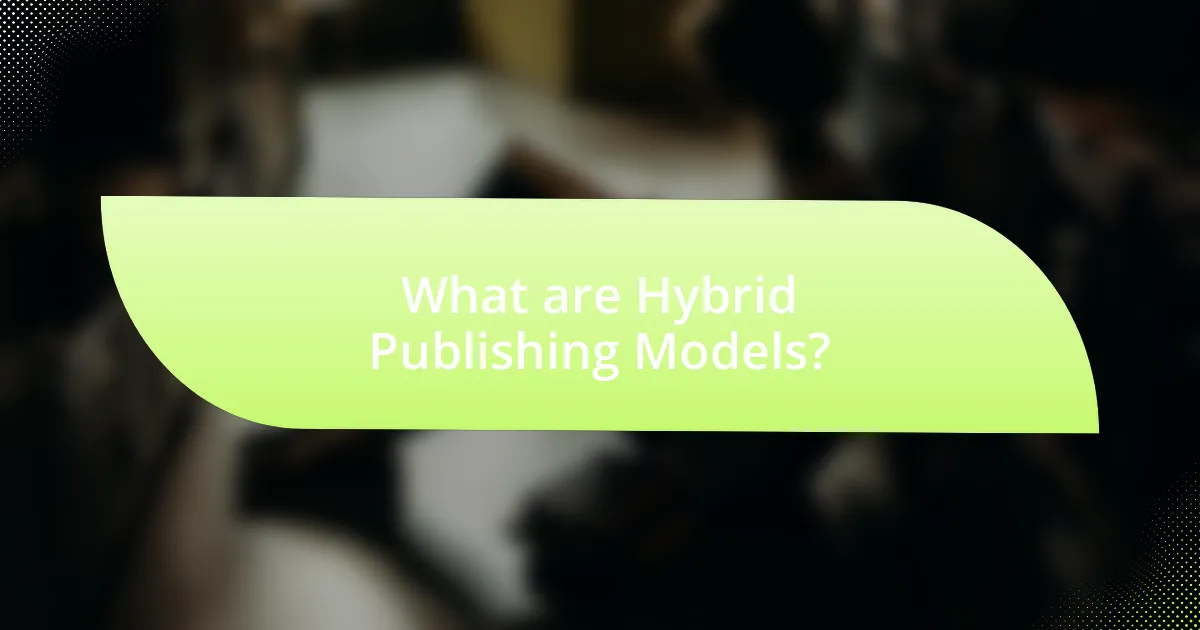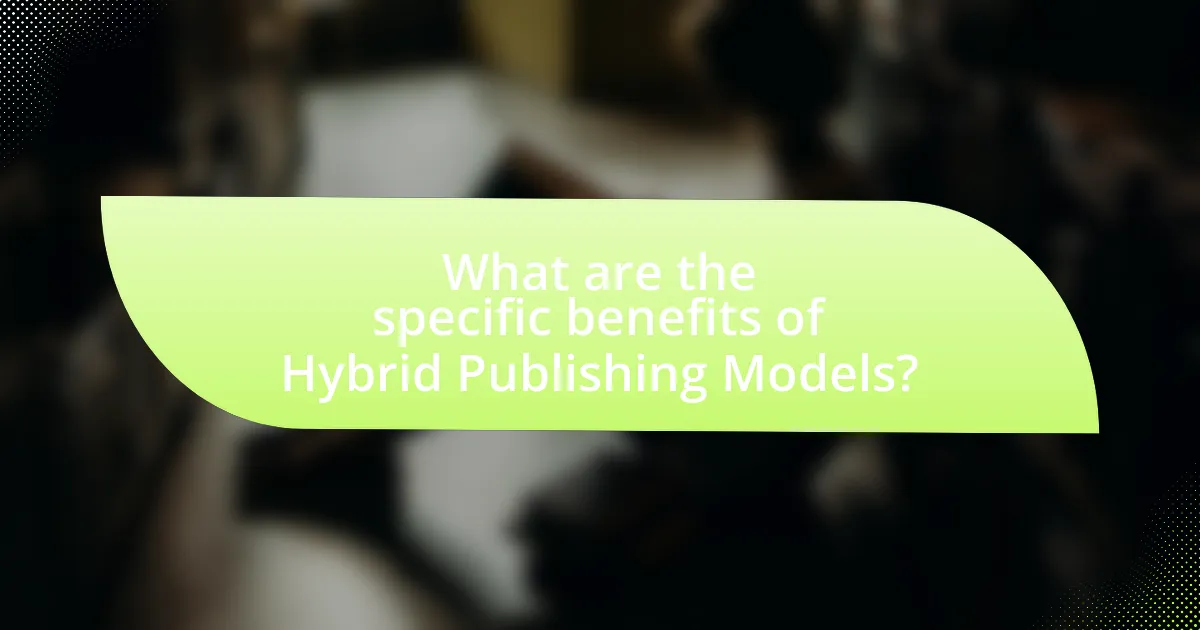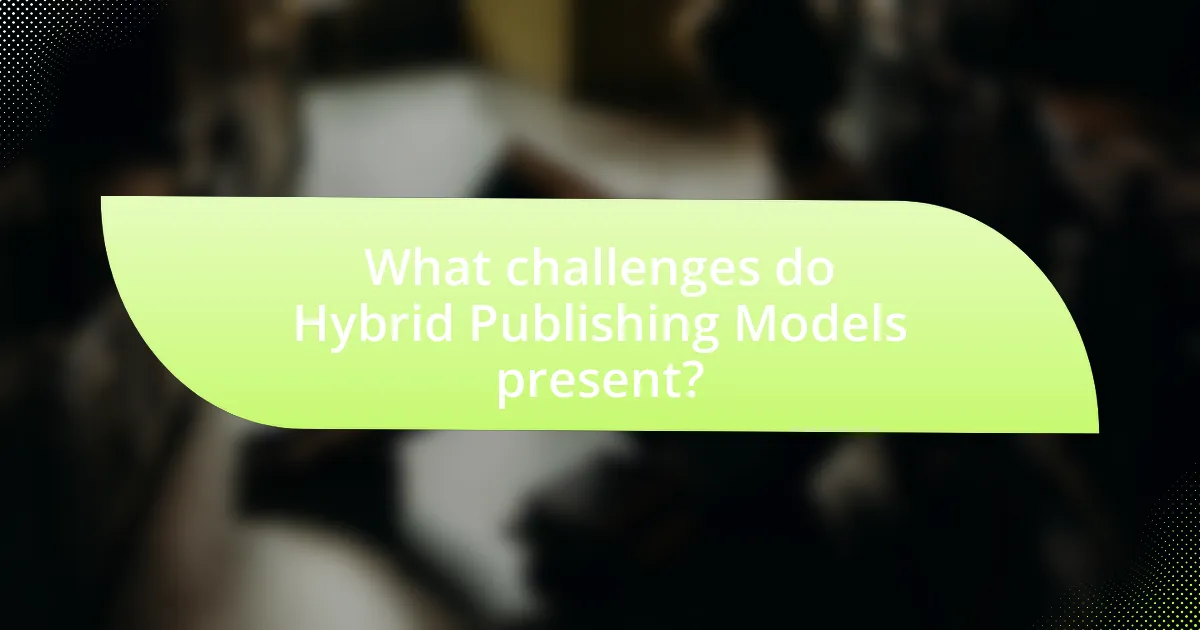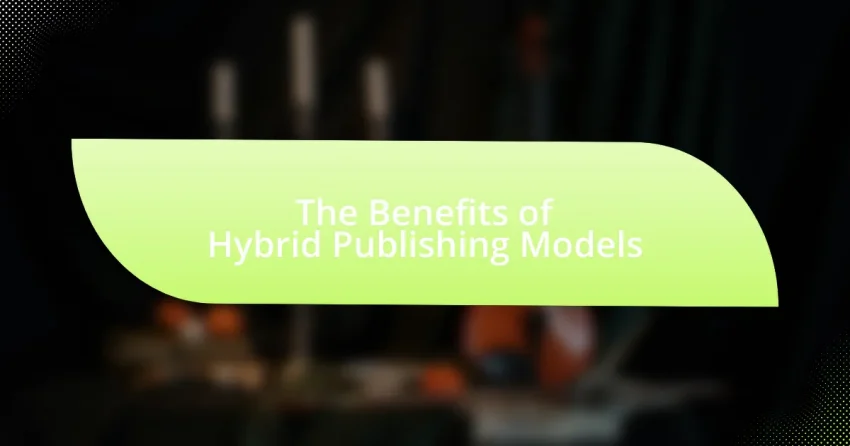Hybrid publishing models represent a blend of traditional and self-publishing, allowing authors to maintain greater control over their work while accessing professional services such as editing, design, and marketing. This approach enables authors to retain more rights and a higher percentage of royalties, making it an increasingly popular choice among writers seeking flexibility and support. Key characteristics include shared financial responsibility, enhanced author control, and the integration of various publishing methods, which cater to the evolving needs of both authors and readers in the digital age. The article explores the benefits, trends, and challenges associated with hybrid publishing, providing insights into how authors can navigate this landscape effectively.

What are Hybrid Publishing Models?
Hybrid publishing models combine elements of traditional publishing and self-publishing, allowing authors to retain more control over their work while still benefiting from professional publishing services. This model typically involves authors paying for certain services, such as editing and design, while also receiving support in distribution and marketing, which are traditionally offered by conventional publishers. According to a 2021 study by the Independent Book Publishers Association, hybrid publishing has gained traction as it offers authors a balanced approach, enabling them to reach wider audiences while maintaining creative control and a higher percentage of royalties compared to traditional publishing.
How do Hybrid Publishing Models differ from traditional publishing?
Hybrid publishing models differ from traditional publishing by combining elements of both self-publishing and conventional publishing. In hybrid publishing, authors typically retain more control over their work and often share in the costs and profits, whereas traditional publishing usually involves a publisher taking on the majority of the financial risk and control over the book’s production and marketing. For instance, hybrid publishers may offer services like editing and design while allowing authors to maintain rights and a larger share of royalties, contrasting with traditional publishers who generally own the rights and provide a smaller percentage of royalties to authors. This model caters to authors seeking a balance between creative control and professional support, reflecting a shift in the publishing landscape.
What are the key characteristics of Hybrid Publishing Models?
Hybrid publishing models combine elements of traditional and self-publishing, offering authors greater flexibility and control over their work. Key characteristics include a shared financial responsibility between the author and publisher, allowing for a more equitable distribution of costs and profits. Additionally, hybrid models often provide authors with access to professional services such as editing, design, and marketing, which are typically associated with traditional publishing. This approach enables authors to retain more rights to their work compared to traditional models, while still benefiting from the expertise and resources of established publishers. Furthermore, hybrid publishing often embraces digital platforms, facilitating wider distribution and accessibility of content.
How do Hybrid Publishing Models integrate various publishing methods?
Hybrid publishing models integrate various publishing methods by combining traditional publishing practices with self-publishing techniques. This integration allows authors to benefit from the resources and expertise of established publishers while retaining greater control over their work and potential profits. For instance, hybrid publishers often provide editorial support, marketing, and distribution services typical of traditional publishing, while also allowing authors to choose aspects of self-publishing, such as pricing and rights management. This model has gained traction, with a report from the Association of American Publishers indicating that hybrid publishing is becoming increasingly popular among authors seeking a balance between creative control and professional support.
Why are Hybrid Publishing Models gaining popularity?
Hybrid publishing models are gaining popularity due to their ability to combine the advantages of traditional and self-publishing, offering authors greater control and flexibility. This model allows authors to retain more rights and royalties while benefiting from professional services such as editing, design, and distribution. According to a 2021 report by the Independent Book Publishers Association, hybrid publishing has seen a 30% increase in adoption among authors, reflecting a growing preference for models that empower creators while still providing essential support.
What trends are driving the adoption of Hybrid Publishing Models?
The adoption of Hybrid Publishing Models is primarily driven by the increasing demand for flexible publishing options that combine traditional and digital methods. This trend is fueled by the rise of self-publishing, which allows authors greater control over their work, and the growing preference for open access, enabling wider dissemination of research. Additionally, advancements in technology facilitate the integration of print and digital formats, making it easier for publishers to reach diverse audiences. According to a 2022 report by the International Association of Scientific, Technical and Medical Publishers, 45% of researchers prefer hybrid models for their ability to enhance visibility and accessibility of published work.
How do authors benefit from choosing Hybrid Publishing Models?
Authors benefit from choosing Hybrid Publishing Models by gaining greater control over their work and access to a wider audience. This model allows authors to combine the advantages of traditional publishing, such as professional editing and distribution, with the flexibility and higher royalties typically associated with self-publishing. For instance, authors can retain copyright and receive up to 70% royalties on sales, compared to the 10-15% offered by traditional publishers. Additionally, hybrid publishing often provides authors with marketing support and resources, enhancing their visibility in a competitive market.

What are the specific benefits of Hybrid Publishing Models?
Hybrid publishing models offer several specific benefits, including increased accessibility, a broader distribution network, and enhanced author control over the publishing process. These models combine elements of traditional and self-publishing, allowing authors to reach diverse audiences while retaining rights and royalties. For instance, authors can publish their work in both print and digital formats, maximizing visibility and sales potential. Additionally, hybrid publishing often provides professional support in editing, design, and marketing, which can improve the overall quality of the published work. This approach caters to the evolving needs of authors and readers in the digital age, making it a versatile option in the publishing landscape.
How do Hybrid Publishing Models enhance author control?
Hybrid publishing models enhance author control by allowing authors to retain more rights and make decisions regarding their work. In these models, authors often have the ability to choose the level of editorial support, distribution channels, and pricing strategies, which empowers them to shape their publishing journey according to their preferences. For instance, a study by the International Association of Scientific, Technical and Medical Publishers indicates that hybrid publishing can lead to increased author satisfaction due to greater involvement in the publishing process. This model contrasts with traditional publishing, where authors typically relinquish significant control over their work.
What aspects of the publishing process can authors control?
Authors can control several aspects of the publishing process, including content creation, cover design, and marketing strategies. Specifically, authors have the autonomy to determine the subject matter, style, and structure of their work, allowing them to express their unique voice and vision. Additionally, they can choose the design elements of their book cover, which plays a crucial role in attracting readers. Furthermore, authors can develop and implement their marketing plans, deciding how to promote their work through various channels, such as social media, book signings, and author events. This level of control is particularly significant in hybrid publishing models, where authors often collaborate with publishers while retaining key decision-making power over these critical elements.
How does increased control impact an author’s success?
Increased control significantly enhances an author’s success by allowing them to make strategic decisions regarding their work, including content, marketing, and distribution. This autonomy enables authors to align their creative vision with market demands, leading to more targeted and effective outreach. For instance, authors who retain rights to their work can adapt their strategies based on real-time feedback and sales data, which can result in higher sales and greater audience engagement. Research indicates that authors with greater control over their publishing process often report higher satisfaction and financial success, as they can tailor their approach to meet their specific goals and audience needs.
What financial advantages do Hybrid Publishing Models offer?
Hybrid publishing models offer financial advantages such as reduced upfront costs for authors and increased revenue potential through diverse income streams. Authors benefit from lower initial investments compared to traditional publishing, as hybrid models often require less financial commitment for production and distribution. Additionally, these models allow authors to retain a larger percentage of royalties, with some estimates indicating that authors can earn up to 70% of their sales revenue, compared to the 10-15% typical in traditional publishing. This combination of lower costs and higher earnings creates a more financially viable option for authors, enhancing their overall profitability in the publishing landscape.
How do revenue-sharing models work in Hybrid Publishing?
Revenue-sharing models in hybrid publishing involve a collaborative financial arrangement where both the publisher and the author share the income generated from the sale of the published work. In this model, the author typically receives a percentage of the revenue, which can vary based on the agreement, while the publisher retains a portion to cover production, marketing, and distribution costs.
For instance, a common structure might allocate 70% of the revenue to the author and 30% to the publisher, incentivizing authors to promote their work actively. This model benefits authors by providing them with a higher potential income compared to traditional publishing, where they often receive a fixed advance and lower royalties. Additionally, hybrid publishing allows for greater creative control and faster publication timelines, enhancing the overall appeal for authors seeking to maximize their earnings and reach.
What are the potential earnings for authors using Hybrid Publishing Models?
Authors using Hybrid Publishing Models can potentially earn between 40% to 70% of the book’s retail price, significantly higher than traditional publishing, which typically offers 10% to 15%. This model allows authors to retain more control over their work and receive higher royalties due to the combination of self-publishing and traditional publishing elements. For instance, a report by the Independent Book Publishers Association indicates that hybrid authors often benefit from better profit margins and increased revenue streams, including print and digital sales, compared to their traditionally published counterparts.

What challenges do Hybrid Publishing Models present?
Hybrid publishing models present challenges such as balancing traditional and digital publishing practices, which can lead to confusion regarding copyright ownership and revenue sharing. This complexity arises because authors may struggle to understand the implications of hybrid agreements, which often combine elements of both self-publishing and traditional publishing. Additionally, the varying quality standards between traditional and self-published works can create inconsistencies in the market, making it difficult for readers to discern credible content. Furthermore, hybrid models may require authors to invest more time and resources in marketing and distribution, as they often retain more control over their work but also bear greater responsibility for its success.
What are the common pitfalls authors face with Hybrid Publishing?
Authors face several common pitfalls with hybrid publishing, including lack of clarity in contracts, inadequate marketing support, and potential financial risks. Many authors do not fully understand the terms of their publishing agreements, which can lead to unfavorable conditions regarding royalties and rights. Additionally, hybrid publishers may not provide sufficient marketing resources, leaving authors responsible for promoting their work without adequate support. Financially, authors might invest significant upfront costs without guaranteed returns, as the hybrid model often requires authors to contribute to production expenses. These pitfalls highlight the importance of thorough research and understanding before engaging with hybrid publishing options.
How can authors navigate the complexities of Hybrid Publishing?
Authors can navigate the complexities of Hybrid Publishing by understanding the balance between traditional and self-publishing methods. This involves researching various hybrid publishing companies to identify those that align with their goals, ensuring they comprehend the financial implications, such as upfront costs and royalty structures. Additionally, authors should seek legal advice to review contracts, ensuring they retain rights and understand the terms of distribution. According to a study by the Independent Book Publishers Association, authors who engage with hybrid models often report higher satisfaction due to increased control over their work and better profit margins compared to traditional publishing.
What resources are available to support authors in Hybrid Publishing?
Authors in hybrid publishing can access various resources, including publishing platforms, editorial services, marketing support, and funding opportunities. Publishing platforms like IngramSpark and Lulu provide tools for authors to publish and distribute their work while retaining rights. Editorial services, such as professional editing and design, enhance the quality of manuscripts, making them more appealing to readers. Marketing support, often offered by hybrid publishers, helps authors reach their target audience through promotional strategies. Additionally, funding opportunities, including grants and crowdfunding platforms, enable authors to finance their projects. These resources collectively empower authors to navigate the hybrid publishing landscape effectively.
How can authors maximize the benefits of Hybrid Publishing Models?
Authors can maximize the benefits of Hybrid Publishing Models by strategically leveraging both traditional and self-publishing avenues to enhance visibility and revenue. By utilizing the strengths of traditional publishing, such as established distribution networks and marketing support, authors can reach wider audiences. Simultaneously, self-publishing allows for greater creative control and higher royalty rates. According to a 2021 survey by the Alliance of Independent Authors, self-published authors reported earning up to 70% royalties compared to the 10-15% typical in traditional publishing. This dual approach enables authors to optimize their reach and financial returns effectively.
What strategies should authors employ for successful Hybrid Publishing?
Authors should employ a multi-faceted strategy for successful hybrid publishing, focusing on building a strong personal brand, leveraging both traditional and digital marketing channels, and maintaining control over their intellectual property. Establishing a personal brand enhances visibility and credibility, which is crucial in a competitive market. Utilizing a combination of traditional marketing methods, such as book signings and media appearances, alongside digital strategies like social media promotion and email marketing, maximizes outreach and engagement with potential readers. Furthermore, retaining control over intellectual property allows authors to negotiate better terms with publishers and adapt their work for various platforms, ensuring they benefit from multiple revenue streams. These strategies are supported by the growing trend of authors successfully navigating hybrid publishing, as evidenced by the increasing number of self-published authors who achieve commercial success while collaborating with traditional publishers.
How can authors effectively market their work in a Hybrid Publishing environment?
Authors can effectively market their work in a Hybrid Publishing environment by leveraging both traditional and digital marketing strategies. This approach allows authors to reach diverse audiences through various channels, such as social media, email newsletters, and book signings. For instance, utilizing platforms like Instagram and Facebook can help authors engage with readers directly, while email marketing can keep their audience informed about new releases and events. Additionally, authors can collaborate with influencers and bloggers to expand their reach, as studies show that 49% of consumers rely on recommendations from influencers when making purchasing decisions. By combining these strategies, authors can maximize their visibility and sales in a Hybrid Publishing context.
What are the best practices for engaging with Hybrid Publishing Models?
The best practices for engaging with Hybrid Publishing Models include understanding the target audience, leveraging both traditional and digital platforms, and ensuring transparency in the publishing process. Engaging with the target audience allows publishers to tailor content effectively, while utilizing a mix of traditional and digital platforms maximizes reach and accessibility. Transparency in the publishing process builds trust with authors and readers, which is crucial for the success of hybrid models. Research indicates that hybrid publishing can increase visibility and citation rates for authors, as evidenced by a study published in the journal “PLOS ONE,” which found that open access articles receive significantly more citations than those behind paywalls.
